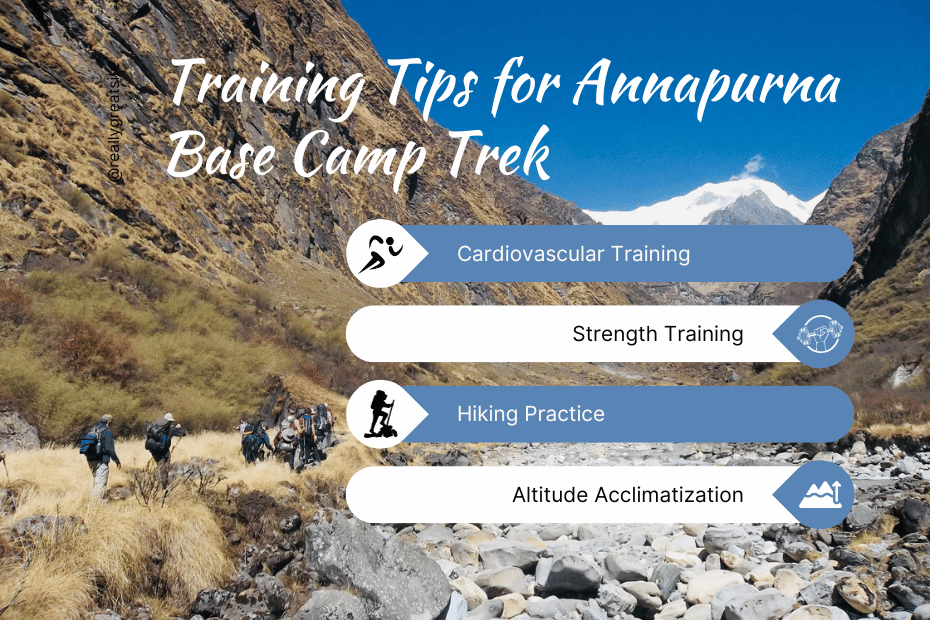Training Tips for Annapurna Base Camp Trek

The Annapurna Base Camp (ABC) Trek is one of the most famous and adventurous trekking experiences in Nepal. To truly enjoy this breathtaking journey, being both physically strong and mentally prepared is essential. Every trek in Nepal demands good stamina, endurance, and a positive mindset.
This beginner’s training guide for the Annapurna Base Camp Trek offers practical tips and exercises to help you get ready. With the right preparation, you can make your ABC adventure safe, enjoyable, and truly unforgettable.

Table of Contents
Aerobic Training (Cardiovascular)
Trekking in the high-altitude environment of the Annapurna Base Camp Trek puts extra pressure on your heart and lungs. At these elevations, the air contains less oxygen, meaning your body must work harder with every breath to supply enough oxygen to your muscles. For beginners, it’s best to start preparing at least 6 months before your trek to adapt your body for the challenge.
Aerobic training is one of the most important parts of preparation. It focuses on light to moderate-intensity exercises that increase your heart rate and improve lung capacity. Activities such as running, cycling, swimming, brisk walking, or stair climbing are highly effective. Including hill training in your routine is especially beneficial as it mimics the uphill trekking conditions you’ll face. If you already go to the gym, you can continue your workouts at your own pace while incorporating more cardio-focused sessions.
By building strong cardiovascular endurance, you’ll make your Annapurna Base Camp journey more comfortable, enjoyable, and adventurous. Regardless of your current fitness level, give yourself enough time to prepare and pace yourself during the trek to fully enjoy the breathtaking Himalayan landscapes.
Building full-body strength is essential for improving your endurance and stability during the Annapurna Base Camp Trek. The trail involves a variety of terrains, from steep uphill climbs to long downhill descents. These constant changes in elevation put your calves, hamstrings, quads, and hip muscles into action, requiring them to be strong and well-conditioned.
However, trekking isn’t just about leg strength. Your upper body, core, and back muscles also play a vital role in maintaining balance and carrying your backpack comfortably. Incorporate a mix of free weights, resistance bands, bodyweight exercises, or gym machines to strengthen both your upper and lower body. Even if you can’t train in the Himalayan environment beforehand, you can prepare by going on regular practice walks or hikes in your local area to simulate trekking conditions.
Strong muscles not only help you move efficiently over rocky and uneven trails but also reduce the risk of injury. Alongside strength training, focus on flexibility exercises to keep your muscles and tendons relaxed and stretchable, making your trek safer and more enjoyable.
Altitude Training
Preparing for high altitude is crucial when trekking to Annapurna Base Camp, which sits above 2,500 meters (8,200 feet). At this elevation, the oxygen level in your blood and muscles drops by nearly 30% compared to sea level, making it harder for your body to function normally.
Altitude sickness is a serious risk for trekkers who ascend too quickly. Common symptoms include headaches, dizziness, nausea, and fatigue. If ignored, altitude sickness can lead to life-threatening complications affecting your lungs and brain.
The golden rule is to never continue ascending if you experience any symptoms of altitude sickness. If symptoms worsen, immediately descend to a lower altitude or seek medical help at a rescue center. Staying well-hydrated throughout your trek is also vital to help your body adjust and reduce the risk of altitude sickness.
Proper altitude training and careful acclimatization are key to a safe and enjoyable Annapurna Base Camp trek.
Mental Preparation
The Annapurna Base Camp Trek is not just a physical challenge—it can be mentally demanding as well. While trekking offers an exciting adventure and beautiful experiences, it can also be tiring and test your patience. Even if your body feels ready, your mind may wander or face moments of doubt during the journey.
This is when mental strength becomes crucial. Finding the inner motivation to keep going, despite fatigue or tough conditions, makes the experience deeply rewarding. Preparing yourself mentally before the trek will help you face challenges with confidence and resilience.
Along with physical training, choose the best time to trek to avoid unnecessary mental stress. Leave behind any expectations of luxury and focus on the incredible culture, nature, and breathtaking landscapes of the Annapurna region. Embrace the adventure, the rich diversity, and the feeling of accomplishment as you trek through some of the world’s highest mountains.
A positive mindset combined with good physical fitness is the key to fully enjoy and succeed on your Annapurna Base Camp adventure.
Picking the Right Itinerary for Annapurna Base Camp Trek
The lodges along the Annapurna Base Camp trail are usually spaced 1 to 2 hours apart, giving you plenty of flexibility to rest and enjoy the journey. If you’re trekking with a guide, porter, or agency, your accommodations will typically be arranged for you.
Here’s a popular Annapurna Base Camp trek itinerary to help you plan your adventure:
- Day 1: Start from Pokhara, take a jeep to Ghandruk, then trek to Chhomrong
- Day 2: Trek from Chhomrong to Bamboo
- Day 3: Trek from Bamboo to Deurali
- Day 4: Trek from Deurali to Annapurna Base Camp (ABC)
- Day 5: Trek from ABC to Himalaya
- Day 6: Trek from Himalaya to Simrung, then jeep ride back to Pokhara
Choose an itinerary that matches your fitness level and trekking style to make the most of your Annapurna Base Camp experience.
Gear and Equipment
Proper gear is a key part of your Annapurna Base Camp Trek training and preparation. Choosing the right equipment ensures a comfortable, safe, and enjoyable trekking experience. This gear list is based on years of trekking knowledge and expert advice from experienced guides in Nepal.
Here’s what you should pack for your trek:
Backpack & Bags
- Day-pack (25-35 liters, comfortable fit)
- Waterproof cover for backpack
Footwear
- Sturdy hiking boots (broken-in)
- Walking or running shoes (for rest days)
- Sandals or flip-flops
- Trekking socks and liner socks
Clothing
- Thermal underwear (2 sets: wool & polypropylene)
- Trekking pants
- Shorts
- Trekking shirts/jerseys
- T-shirts
- Underwear
- Warm fleece jacket
- Down jacket
- Windproof and waterproof jacket
- Warm hat and sun hat/cap
- Thin gloves and thick mittens or ski gloves
- Turtleneck or light scarf
Sleeping Gear
- Warm sleeping bag
- Fleece inner bag
- Thin sleeping bag liner
Accessories & Essentials
- Trekking poles
- Good sunglasses
- Headlamp with extra batteries
- Water bottle or hydration system
- Sunscreen (high protection)
- Lip balm with SPF
- Hand sanitizer
- Pocket knife
- Small towel
- Snacks and energy bars
Health & Safety
- First aid kit (painkillers, band-aids, disinfectant, etc.)
- Personal medications
Documents & Electronics
- Passport, money, and travel documents
- 4-6 passport photos (for permits)
- Camera, charger, spare batteries, and memory cards
- Diary or notebook and pen
Extra Guidelines for Annapurna Base Camp Trek Training
- Most importantly, remember you are on holiday—take time to enjoy the stunning landscapes, rich culture, and the adventure itself!
- Avoid alcohol and caffeine, as they can dehydrate your body and increase the risk of altitude sickness.
- Protect yourself from the strong Himalayan sun by wearing sunscreen, sunglasses, and a hat.
- Stay well-hydrated by drinking plenty of water throughout your trek to help reduce altitude sickness symptoms.
- For multi-day trekking, try to trek to higher altitudes during the day and descend to lower elevations to rest at night. This helps your body acclimatize better.
Benefits of Annapurna Base Camp Trek Training
Preparing well for the Annapurna Base Camp Trek offers many advantages that make your journey safer, easier, and more enjoyable:
- Improved Stamina and Endurance: Training boosts your cardiovascular fitness, helping you handle long days of trekking without excessive fatigue.
- Stronger Muscles: Strength training prepares your legs, core, and upper body to tackle uneven trails, steep climbs, and carrying your backpack comfortably.
- Better Altitude Adaptation: Physical preparation combined with proper acclimatization reduces the risk of altitude sickness and helps your body adjust smoothly.
- Mental Resilience: Training builds confidence and mental toughness, so you’re ready to face unexpected challenges on the trail.
- Injury Prevention: Proper conditioning and flexibility exercises reduce the chances of common trekking injuries like sprains and muscle strains.
- Enhanced Enjoyment: When you’re fit and well-prepared, you can fully appreciate the stunning landscapes, rich culture, and adventure of the Annapurna region.
Final Thoughts
Once you’re physically and mentally prepared, all you need is focus and a positive attitude to conquer the Annapurna Base Camp trek. The fitter and stronger you are, the more enjoyable and unforgettable your trekking adventure will be.
If you have any questions about training for the Annapurna Base Camp trek, please don’t hesitate to reach out. We’re here to help and will respond to you as soon as possible.
Posted on








